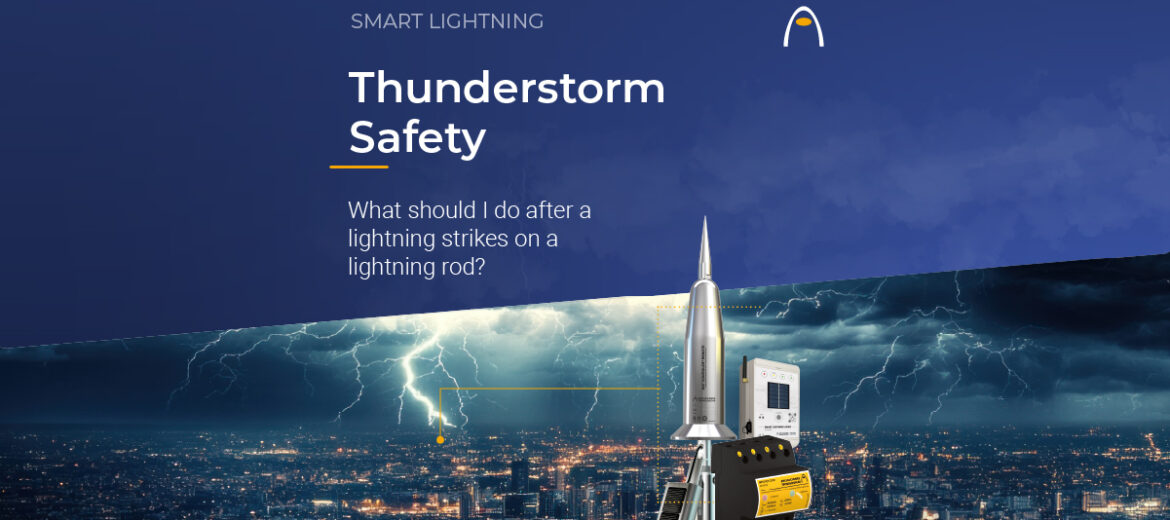A lightning protection system prevents a direct strike on the structure, but it does strike the lightning rod. Therefore, when a discharge occurs, the entire lightning protection system must be thoroughly checked and reset, as the integrity of critical components (lightning rods, conductors, connections, grounding, etc.) may be compromised. Following a post-impact protocol ensures that the system continues to function properly and the installation remains protected.
The introduction of smart technology that remotely reports on the status of these systems also offers extra security by anticipating repairs beyond visual inspections and periodic checks.
What do we mean when we talk about a lightning protection system?
By definition, a Lightning Protection System (LPS) aims to capture lightning, conduct its current safely to earth, dissipate it into the ground and protect against the secondary effects of lightning.
Lightning protection systems differentiate between external protection elements and internal protection elements. External protection elements usually consist of one or more air terminals (lightning rods), two or more down conductors and an earthing system.
Lightning protection system: external protection
An Early Streamer Emmision air terminal (ESE) is distinguished by continuously generating an upward tracer that intercepts the downward tracer of the lightning before any other structure within its range. When an ESE lightning rod advances the creation of this upward tracer (i.e., it has a longer advance time), it can capture the downward tracer from a greater distance and, therefore, protect a larger area. The protection radius corresponding to each height is determined based on the advance time of the lightning rod and the level of protection required by each structure.
The lightning rods in the DAT CONTROLER® range from Aplicaciones Tecnológicas S.A. feature the latest technology in priming devices. In addition, the DAT CONTROLER® REMOTE intelligent lightning rod has self-diagnosis of the head and communication via IoT of the result to ensure the correct operation of the equipment.
Devices such as the SMART LIGHTNING LOGGER intelligent lightning counter from Aplicaciones Tecnológicas S.A. can be installed on the SPCR down conductor, which sends real-time alerts when lightning strikes the structure. In addition to the warning, the SMART LIGHTNING LOGGER collects all the information about the discharge.
The earth connection is an essential component of the external lightning protection system, as it is responsible for safely dispersing the discharge current into the ground. Its effectiveness depends on the conductivity of the soil, which is predominantly electrolytic due to the salts dissolved in the water that moistens it. Therefore, this conductivity can be enhanced by improving the soil’s ability to absorb and retain water, as well as by increasing the concentration of soluble salts.
Internal protection – Surge protection
An internal lightning protection system must also incorporate a suitable surge protection installation, together with other measures to reduce damage (equipotential bonding, shielding, etc.). Although transient overvoltages can originate in different ways, the most harmful ones come from lightning. These extremely short voltage peaks reach the equipment through the power, telephone, television or data networks. Surge protection ensures continuity of service by reducing the risk to people and property to acceptable levels. Surge protection devices (SPD) remain inactive while the electrical signal remains within its normal values, but react immediately to transient surges, shunting the lightning current to ground and safeguarding the equipment. Once the surge is absorbed, the SPD returns to its quiescent state.
There are three types of DPS:
- Type 1: Face the direct lightning discharge and are installed where the current and electromagnetic effects have not yet been attenuated (main frames).
- Type 2: This type act against indirect lightning effects, at points where the energy is already attenuated (secondary frames).
- Type 3: Protect against very low residual overvoltages and are placed as close as possible to sensitive equipment.
Lightning strike – Visual inspection after the event
- Following a lightning strike on the lightning rod, a thorough visual inspection of all visible components of the system should be performed as soon as possible. This initial check is intended to identify obvious damage caused by the enormous energy of the lightning strike. It is recommended to check, among others, the following key points:
- Lightning rod head: check that there is no deformation, partial melting or burn marks caused by the impact. The extreme current of the lightning strike often overheats the tip; in severe cases, part of the head material may melt and disappear due to the heat. A damaged head should generally be replaced with a new one with the same characteristics.
- Structure and mechanical elements: check that the mast and its fixings are intact and secure, with no loosening or excessive corrosion. The lightning strike can loosen supports or damage anchors, so the mechanical condition of clamps, screws and mounting brackets must be checked, reinforcing or replacing any fastenings in poor condition.
- Down conductors: inspect the down conductor (conductor between the lightning rod and the earth connection) along its entire length. Ensure that it remains continuous, with no breaks or burnt sections. Pay attention to signs of wear on the conductor: in very intense discharges, the copper may have overheated to the point of altering its physical properties (cables that have lost their original mechanical strength or conductivity). Also check the clamps and brackets that secure the conductor to the structure, making sure they are not broken, loose or corroded. If any show damage or advanced corrosion, they must be replaced.
- Equipotential bonds: check all equipotential connections (e.g. links to other metal masses in the structure). These bonds must be intact and tight, with no signs of corrosion or sparking. An impact can generate overvoltages that affect nearby metal parts, so it is crucial to confirm that there is no damage or separation in the connections responsible for equalising potentials. Any loose connectors must be readjusted; if arcing or carbonisation is observed, these elements must be cleaned or replaced.
- Additional installation elements: if the system has devices such as an electromechanical lightning counter (impact recorder) or spark gaps (insulation gaps), these should also be visually checked. For example, read the lightning counter to see if it actually recorded the discharge and make sure it is still working properly. The presence of a counter makes it easy to know how many strikes the system has received, and it is very useful for determining the need for extraordinary inspections. Likewise, any spark gap or similar device should be inspected to verify that it has not suffered a side discharge.
During this visual inspection, it is important to document any findings (damage, missing parts, etc.) with photographs and notes. All external elements of the lightning rod must be kept intact and stable. In summary, the visual inspection seeks to identify obvious physical damage to the collector, down conductors and connections, as these will reveal points where lightning may have caused damage.
Technical checks and system tests
After the visual inspection, technical tests must be carried out to ensure that the system is functioning correctly at an electrical level. These tests include checking electrical continuity, measuring earth resistance and checking associated protection devices:
- Checking the lightning rod. The proper functioning of the lightning rod is essential for the PDC to maintain its advance time and therefore its protection radius. Therefore, after the impact, the correct functioning of the active head must be verified following the manufacturer’s instructions. Aplicaciones Tecnológicas’ DAT CONTROLER REMOTE lightning rods have remote verification that allows the status of the igniter to be tested without accessing the head. Other equipment allows on-site testing. If these testers are not available, the head can be lowered (following safety procedures) and sent to a laboratory or technical service to check that it continues to meet its activation parameters.
- Electrical continuity of conductors: Using the appropriate instrumentation, such as an ohmmeter, check that the down conductor has electrical continuity from the head to the earth connection and that the electrical resistance is low (close to zero). This confirms that the path to the ground has not been interrupted. According to regulations, the continuity of the conductors must be correct at all times; if an interruption or an abnormal increase in resistance is detected, this may indicate broken cables, faulty splices or loose connections due to impact. In such a case, the connections must be repaired or the damaged section of the conductor replaced before the system is put back into service.
- Earth resistance measurement: It is essential to measure the earth resistance of the lightning conductor after a lightning strike. The effectiveness of the system depends on the lightning current dissipating quickly into the ground, which typically requires low earth resistance. In practice, it is recommended that the earth resistance value be less than 10 Ω (ohms). After a storm, this value may have changed (due to changes in soil moisture, compaction, damage to electrodes, etc.), so it should be checked with a ground resistance meter. Ideally, the three-point method (potential drop method) or another approved method should be used, momentarily disconnecting the main ground connection to measure it in isolation. Suppose the measured resistance exceeds the recommended value. In that case, action must be taken: for example, improving the grounding system by adding more electrodes or additional rods, using conductivity-enhancing additives in the ground, or checking the connections of the existing electrodes. In well-designed installations, the earth network usually includes inspection chambers; these should be used to check that the conductors and connections to the spikes show no signs of corrosion or overheating. Periodic inspection of the earth is mandatory in many countries – at least once a year – and always after a significant lightning strike.
- Verification of internal protection devices: If the installation has surge protection devices (SPDs) or arresters (in the electrical panel, on data lines, etc.), they should be inspected after the storm. Even if the lightning has been intercepted by the lightning rod, it does not prevent electromagnetic fields from inducing surges in the lines. SPDs are designed to divert these surges to ground, but in doing so, they can become unusable. It is important to check that there are no signs of failure in the SPDs. If any protector shows signs of failure, it must be replaced immediately, as it has lost its ability to protect. This technical inspection ensures that the internal protection of the installation (electronic equipment, communication systems, electrical appliances, etc.) remains effective.
- Lightning alert system and lightning counters: If installed, it is important to check the lightning counter. These counters record the passage of the discharge current when a strike occurs, and their reading must be noted to keep a record of the event. In addition, some systems integrate smart loggers such as the SMART LIGHTNING LOGGER from Aplicaciones Tecnológicas S.A., which sends real-time alerts when lightning strikes the structure. Checking that these alarm and monitoring systems are working (e.g., active IoT communication signal, records stored correctly) ensures that any new strikes can be detected and dealt with quickly in the future.
If any deterioration or anomaly is detected, the necessary repairs must be carried out as soon as possible to restore the effectiveness of the system. It is not acceptable to keep a lightning rod with damaged components in service, as it could fail in its main function of protecting the structure on which the system is installed in the event of a subsequent event. For example, a partially melted head has blunt tips that can affect its ability to capture the next lightning strike; a conductor with sections reduced by heat may not conduct the current properly; a high-resistance ground connection can cause dangerous sparks or unwanted diversions. After repair, each component must be in a condition equivalent to the original design to ensure safety.
Regulations and standards on the maintenance of lightning protection systems after a strike
Both international and national technical regulations establish the need to inspect and maintain lightning protection systems periodically, and especially after a direct strike. Some of the most relevant are:
- UNE 21186:2011 (Spain) – Lightning protection: Lightning conductors with early streamer emission devices. This Spanish standard regulates the design, installation, inspection and maintenance of installations with lightning conductors with early streamer emission devices (ESED). It is frequently applied in buildings where active lightning conductors are installed in Spain and other countries. UNE 21186 requires periodic inspections of these systems to ensure their effectiveness in protecting people and property, detailing inspection procedures similar to those described (checking the head, down conductors, earth, etc.). After a lightning strike on a PDC lightning conductor, UNE 21186 indicates that a complete inspection of the system must be carried out.
- UNE-EN IEC 62305 series (International) – Lightning protection (Parts 1 to 4). This is the national adoption of the international standard IEC 62305. In particular, Part 3 (UNE-EN 62305-3) addresses the protection of structures against physical damage and contains requirements for the inspection and maintenance of Lightning Protection Systems (LPS). This standard establishes that an LPS must be inspected both periodically (depending on the level of protection, see below) and whenever it is suspected that it may have been struck by lightning. Part 4 (UNE-EN 62305-4) deals with the protection of internal electrical/electronic systems and also includes maintenance guidelines to ensure that earthing and surge protection systems remain in good condition. According to IEC 62305, it is mandatory to check the installation after any known lightning strike on the structure. This requirement is reflected, for example, in the recommendation to install lightning counters that warn of such strikes.
- NFPA 780 (USA) – Standard for the Installation of Lightning Protection Systems. Although it is a US standard, it is an international benchmark. NFPA 780 recommends periodic inspections of lightning rods to ensure their integrity. In particular, it suggests that an extraordinary inspection of the system be carried out after major thunderstorms or direct strikes. It also recommends inspection after any modification to the protected structure or if damaged components have been found. The philosophy of NFPA 780 is preventive: at least one visual inspection per year and a complete verification every few years, ensuring that the system continues to comply with the current standard. Although NFPA 780 is not mandatory outside the US, many of its criteria (e.g., inspection after lightning strikes, conductor continuity, use of listed components) are good practices adopted globally.
- Additional Spanish and European regulations: In Spain, the Technical Building Code (CTE) in its Basic Document SUA-8 establishes the need to limit the risk associated with lightning through adequate installations, which also implies maintaining these installations in safe conditions. The Low Voltage Electrotechnical Regulations (REBT) and its technical guides mention protection against overvoltage and earth faults, requiring electrical installations (including earthing systems) to be safe and properly maintained. In addition, there are specific European standards for components, such as the UNE-EN 62561 series, which set requirements for connection parts, conductors, electrodes, lightning meters, etc., ensuring their quality and resistance to discharges. All these standards together form the regulatory framework that highlights the importance of checking that all elements of the SPCR are in good condition through continuous preventive maintenance.
- Frequency of inspections according to protection level: Technical standards often define maximum intervals between inspections. For example, the IEC 62305 guide suggests that for level I or II (high risk) systems, there should be annual visual inspections and comprehensive biennial inspections, while for levels III-IV, visual inspections every two years and comprehensive inspections every four years are acceptable. However, after a lightning strike, these inspections must be carried out immediately. In practice, many national regulations (including those in Spain) require at least one annual review and always one after any lightning strike or structural renovation of the building. Failure to comply with these reviews could mean that the system does not meet the required safety conditions, with the consequent risk and possible legal implications if lightning damage occurs with the system negligently maintained.
If you have any questions about lightning rod maintenance or what to do after a strike, don’t hesitate to get in touch with us by clicking here.
If you wish, you can also attend any of our free online training courses on lightning protection on our webinars page.



